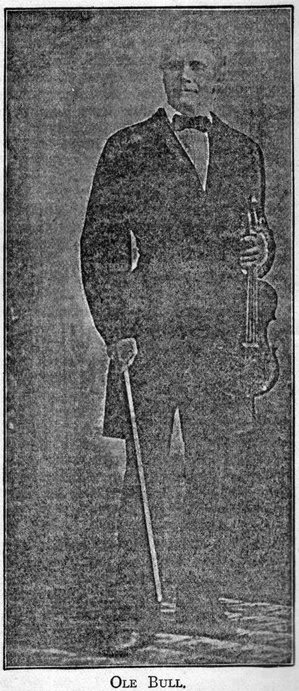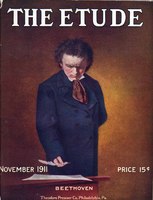It is astonishing at what an early age some violinists begin to rely on themselves. In a lecture in Vienna recently, Bronislaw Huberman, an eminent European violinist, who was a noted prodigy in his childhood, stated that regular instruction ceased with him at the age of 12. After that he was his own teacher. It must be remembered, however, that he had had some lessons from an eminent teacher and that at 12 his technic was far advanced. At 13, Mischa Elman, now one of the world’s most famous violinists, was a finished artist, and from that age he began a series of tours which expended all over the world. He told the writer that his whole style and conceptions changed after his lessons stopped, so much so that his teacher, Leopold Auer, greatly marveled at the different character of his playing, when he heard him in London a year or two after his lessons ceased.
Paganini, in his boyhood, had some lessons from his father, from one Servetto a theatre musician, from Costa a well-known violinist, from Ghiretti, and probably from Rolla, but he got through with what the teachers of his day had to teach him while yet a boy, and on this limited foundation, built up by his own exertions, his stupendous technic, worked out his marvelous compositions, and practically recreated the art of violin playing. While doing this, he would for months at a time practice ten and twelve hours a day with the most intense enthusiasm, sometimes falling back completely exhausted from the intensity which he threw into his work.
HOW TARTINI PICKED UP HIS KNOWLEDGE.
Tartini, the famous Italian violinist and composer of music for the violin, whose compositions are still heard on the concert platform, practically “picked up” his knowledge of violin playing from hearing and watching other violinists, although he seems to have had some lessons in theory and harmony and in choir work. He seems to have used his own ideas in violin playing up to the time he heard Veracini, another great Italian violinist, when he perceived many points in which his own technic was deficient, and set about to correct them, using the style of Veracini as a model. He retired to Ancona for this purpose, where he spent several years in severe study. He was a man of great ingenuity, and did much to further the art of violin teaching as well as playing. He created the Paduan school of violin playing, and formed a large number of eminent pupils.
Alexandre Jean Boucher, a French, and Antonio Lolli, an Italian violinist, while poor theoretical musicians, were both mainly self-taught, and developed great technical powers. In technical feats Boucher is said to have been surpassed only by Paganini. Both violinists traveled extensively in Europe, giving concerts by which they attained great fame.
Ole Bull, the great Scandinavian violinist, is usually classed as self-taught, since, while he had lessons in his youth for a limited time, the greater portion of his violin playing was self-developed. As a child he became passionately fond of the violin through hearing weekly string quartet rehearsals, in which his uncle Jens played the ‘cello. His uncle gave him his first violin when he was five years old, and such was his talent that he learned to play all the melodies he heard surprisingly well without regular instruction. His first regular instructor was a musician named Paulsen, the first violin of the quartet which Ole heard practice. His next teacher was a Swedish violinist named Lundholm, a pupil of Balliot, who did much for his technic. Later in his career he had lessons for a few months at a time from able teachers, but he never enjoyed the systematic training such as is given by the conservatories of leading European cities. He begged Spohr to give him lessons, but the great German refused him as a pupil. The turning point of his life came when he heard Paganini in Paris, when he was 21 years of age. The Italian wizard made a tremendous impression on him, and he threw himself into his studies without the aid of a teacher, with the greatest ardor, seeking to acquire the wonderful technical skill of Paganini.
Musical authorities are pretty generally agreed that Ole Bull would have been a far greater artist if he could have enjoyed the guidance of some great violinist during the first few years of his studies, but, be that as it may, there are certainly few violinists who have won greater fame, honors and emoluments, and few who have given a keener enjoyment to a greater number of audiences.
OTHER FAMOUS EXAMPLES.
Remenyi, the Hungarian violinist, is said to have enjoyed but three years of regular instruction, he having studied between the ages of 12 and 15 at the Vienna Conservatory, under Joseph Bohm. The balance of his education was obtained by his own exertions and hearing other violinists play. He traveled all over the civilized world and won universal fame as a solo violinist.
Sivori, the famous Italian violinist, is said to have cried for a violin when between two and three years old. His father bought him a small violin, upon which he learned to play many melodies he heard his sisters play, simply by instinct. At the age of six he became the pupil of Paganini, who took great interest in him, and wrote several compositions for him.
Carrodus, the eminent English violinist, was the son of a barber, and walked ten miles to take lessons on the violin. He also devoted himself night and day to learning all he could about violin playing in addition to the aid he received from his teacher. Petschnikoff, one of the most famous living violinists, lived in Moscow when a child. He showed such talent in mastering the rudiments of violin playing without a teacher that he was taken into the conservatory through the influence of a member of the Royal Opera House who heard him play. His biography states that he earned some money by teaching as early as ten years of age. Willy Burmester, now one of the most famous violinists of Europe, studied four years with Joachim, at the Berlin Hoch-schule, but was refused a certificate. He then went to Finland to practice according to his own ideas and theories, continuing the work for three years, during which period he practiced nine or ten hours a day. Emerging from his retirement he visited Berlin, the city where he had been refused a degree, and was acclaimed a new star on the occasion of his first concert. His success since that time has been remarkable. Brodsky, the famous Russian violinist, owned his first violin at the age of four, and with a little home instruction soon learned to play Russian folk songs.
The above incidents, culled at random from the lives of great violinists, show how much these great men were able to accomplish by their own efforts, supplementing that which they learned from teachers.




